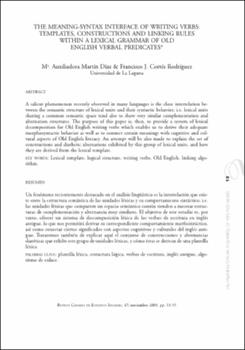The Meaning-Syntax Interface of Writing Verbs: Templates, Constructions and Linking Rules within a Lexical Grammar of Old English Verbal Predicates
Fecha
2003Resumen
Un fenómeno recientemente destacado en el análisis lingüístico es la interrelación que existe
entre la estructura semántica de las unidades léxicas y su comportamiento sintáctico; i.e.
las unidades léxicas que comparten un espacio semántico común tienden a mostrar estructuras
de complementación y alternancia muy similares. El objetivo de este estudio es, por
tanto, ofrecer un sistema de descomposición léxica de los verbos de escritura en inglés
antiguo, lo que nos permitirá derivar su correspondiente comportamiento morfosintáctico,
así como conectar ciertos significados con aspectos cognitivos y culturales del inglés antiguo.
Trataremos también de explicar aquí el conjunto de construcciones y alternancias
diatéticas que exhibe este grupo de unidades léxicas, y cómo éstas se derivan de una plantilla
léxica. A salient phenomenon recently observed in many languages is the close interrelation between
the semantic structure of lexical units and their syntactic behavior; i.e. lexical units
sharing a common semantic space tend also to show very similar complementation and
alternation structures. The purpose of this paper is, then, to provide a system of lexical
decomposition for Old English writing verbs which enables us to derive their adequate
morphosyntactic behavior as well as to connect certain meanings with cognitive and cultural
aspects of Old English literacy. An attempt will be also made to explain the set of
constructions and diathetic alternations exhibited by this group of lexical units, and how
they are derived from the lexical template.






